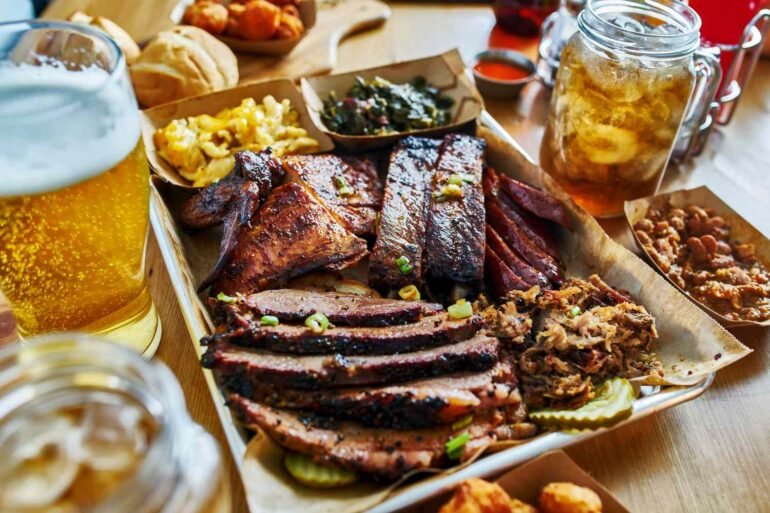:max_bytes(150000):strip_icc():format(jpeg)/The-New-Rules-of-Beer-and-BBQ-Pairing-FT-DGTL1125-e7f79cdb188c41d28bd279106e66501f.jpg)
- Beer educator Anne Becerra is reframing traditional barbecue pairings by focusing on the sauce first, demonstrating how beer can enhance a wide variety of flavor profiles.
- Her seminar at the Food & Wine Classic in Charleston will explore how beer’s breadth — from hefeweizen to porter — can complement sauces where wine often clashes.
- Meanwhile, experts like Hank Shaw and Jacob Hadjigeorgis highlight that the best pairings are personal and flexible, guided by regional culture and individual taste.
When the Food & Wine Classic in Charleston kicks off this year, beer educator Anne Becerra will be asking a deceptively simple question: What happens when you start with the sauce?
For years, the conventional wisdom around barbecue and beer has relied on a few familiar pairings — a light lager with ribs, an IPA with spice. They work, but they also flatten the conversation, ignoring the nuances of sauce styles and the diversity of beer. Becerra, one of the country’s most respected voices on beer education, wants to reframe the conversation. “I like to think of beer as an extension of the meal,” she says. “You don’t have to recreate the wheel. If you’d put a sauce on roast duck, you can sub in a beer with those same flavors.”
Her upcoming Charleston seminar — BBQ Sauce & Brews: Pairing Pints with Spicy, Sweet, Tart, and Tangy Sauces — will use six sauces, including South Carolina’s mustard-based Carolina Gold and Korean barbecue, as the starting point for a new way of thinking about pairings. The idea is less about memorizing rules and more about giving people tools to trust their instincts. “Everyone already creates pairings every day,” she explains. “If you dip a French fry in ketchup, you’re doing it. This is just about paying attention to what works and why.”
Chef and author Hank Shaw reminds us that beer is barbecue’s most natural companion, although for him the appeal is partly cultural. “Beer is way more appropriate for barbecue than wine,” he says. “Wine hates vinegar, and vinegar is in so many sauces. With beer, you don’t have that problem.” Shaw, whose new book Borderlands explores the flavors of the U.S.–Mexico border, is quick to point out that the best pairings aren’t always the obvious ones.
He recalls drinking porters with Kentucky mutton barbecue, where the sauce’s Worcestershire-driven depth matched the beer’s heft, and reaching for a gose or shandy to echo the tang of vinegar-heavy sauces. And sometimes, he insists, the simplest choice is the right one: “If I’m eating barbecue in Texas, I’m probably drinking a Lone Star. In South Carolina, maybe a Budweiser. There’s nothing wrong with a straightforward lager.”
Beer pairing made simple
- Start with the sauce. Meat matters, but sauce dictates the dominant flavor profile — tangy, sweet, spicy, or smoky. Matching beer to sauce unlocks more precise, satisfying pairings.
- Beer thrives where wine struggles. Vinegar, spice, and smoke can clash with wine, but beer’s range — from malty lagers to bright sours — makes it a more versatile partner.
- Keep it flexible. From porters with Kentucky mutton to a simple Lone Star with brisket, the “rules” are more like suggestions. Pairings can be instinctive, nostalgic, or purely about refreshment.
At Jacob’s Pickles in New York City, owner Jacob Hadjigeorgis sees the same principles play out in real time. His menu features two signature sauces — a Kansas City molasses style and a creamy Alabama white — and an expansive beer list designed to guide guests from familiar lagers to more adventurous farmhouse ales or rauchbiers.
“Our first goal is to find the style of beer they actually like,” he says. “From there, we can steer them toward something that complements the food in a new way — maybe a farmhouse ale that cuts through fried chicken, or a smoky porter that feels tailor-made for saucy ribs.”
Together, these perspectives set the stage for Becerra’s sauce-by-sauce guide — a framework that works as well for festival-goers in Charleston as it does for anyone standing in front of the beer aisle at home.
| Sauce by sauce: How to pair beer with barbecue | ||
|---|---|---|
| SAUCE | BEER PAIRING NOTES | BEER EXAMPLES |
| Carolina Gold (Mustard-Based) | Tangy, a little sweet, and spiced, this South Carolina classic finds its match in a Hefeweizen. The beer’s fruity, clove-tinged notes echo the sauce’s complexity, while its gentle sweetness softens the vinegar’s bite. | Ayinger Brau Weisse, Schneider Edel Weiss, Two Brothers Ebel’s Weisse |
| Vinegar and Pepper | Sharp and fiery, this sauce can overwhelm. A malty Oktoberfest lager acts like bread on the plate — biscuity, honeyed, and clean, it steadies the heat and acidity without dulling the flavor. | Munkle Haus Bier, Hofbräu Oktoberfest, Paulaner Oktoberfest |
| Mild Tomato | Savory and caramelized, this style pairs beautifully with a Belgian Dubbel. Notes of dried fruit and toffee amplify the sauce’s depth, while lively carbonation scrubs the palate between bites. | Chimay Première Red, Westmalle Dubbel, Ommegang Abbey Ale |
| Heavy Tomato | Richer and sweeter, this tomato-forward sauce shines with a Brown Ale. Toasty and nutty, with hints of chocolate, the beer mirrors the sauce’s cooked, caramelized flavors while staying dry enough to refresh. | Brooklyn Brown Ale, Samuel Smith’s Nut Brown Ale, Avery Ellie’s Brown Ale. |
| Korean Barbecue | Salty, garlicky, and tangy, Korean barbecue often pairs with soju — but fruit beers offer a playful spin. Raspberry- or tropical-tinged brews add brightness, tame spice, and complement smoky char. | Grimm Artisanal Ambient Fizz (Raspberry), Lindemans D’Or Tropical, Rodenbach Fruitage |
| Tamarind Barbecue | Bold, spicy, and layered, tamarind sauce calls for balance. A golden ale with gentle sweetness and a crisp finish refreshes the palate without competing with the sauce’s intensity. | Edmund’s Oast Something Cold, St. Feuillien Blonde, Tree House Blonde |
Gina Pace
2025-11-04 18:01:00

